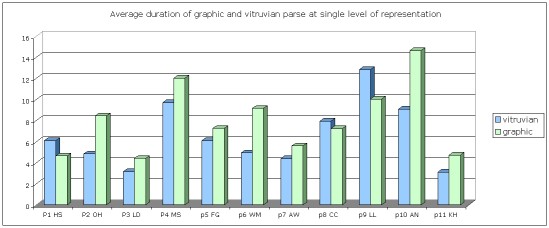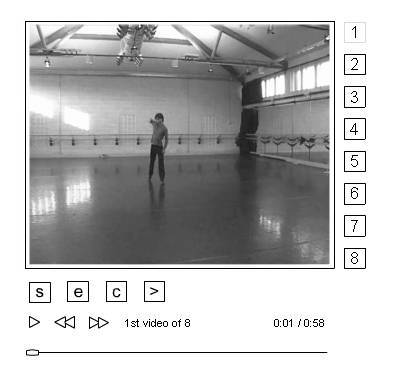ON-LINE (H)
This is the section where we are developing an on-line continuation of experiments that took place during PHASE II (a special thanks to Matt Bilson for his development work).
THE VIEWING AND PARSING EXERCISE (ORIGINAL)
This experiment was designed by Phil Barnard and Tony Marcel (see Phase II: Experiments #4) to look at the question of what sources of variation underlie observations and interpretations of dance as it evolves over time. The participants in the experiment were Wayne McGregor and his company of ten dancers, and some of these results are explored in the article by Scott deLahunta and Phil Barnard: "What's in a Phrase?" (see papers).
THE SETUP: Following two different sets of specific instructions provided by McGregor, four dancers from the company generated eight short movement sequences (two each) specifically for the viewing and parsing exercise. Four were developed following a set of points in space/location [vitruvian] instructions and the other four following instructions that were more graphic and image based. These were created and set (not improvised) then each was performed immediately three times and videotaped; with one performance of each sequence to be selected for the viewing exercise. The final eight sequences that were selected varied in duration from 25 to 120 seconds and were converted to a digital video format that allowed presentation during the viewing exercise using Quicktime software. This made it possible for the viewers to directly control playback using the control buttons, cursor keys or direct manipulation via the playback head. In addition the movie information window showed the time associated with the current frame being displayed, and the soundtrack was deleted to leave only motion cues for the viewers.
VIEWING AND PARSING: The viewing and parsing itself demanded very specific viewing and response instructions for each participant. In the first viewing, they were asked to watch one of the movement sequences without pausing. In the second pass, they could pause the action or move about the piece using the player controls. On the third pass they asked to 'parse' or divide the sequence into units of their own choosing and enter these times into the response forms. On a fourth and final pass they were asked to review and confirm their unitisation.
The original instructions and response forms can be downloaded here.
Download Original Instructions in .doc (Word 6.0/95) format
Download Original Response Form in .doc (Word 6.0/95) format
SOME RESULTS: An initial analysis of the collected data provided a way of looking not only at what one dancer perceives to be a single unit but how perceptions might be compared in relation to two different types of instructions for generating movement material as well as across the company. In this context, the parsing system and graphs such as the following have been discussed as a 'pattern recognition tool'; giving rise to interesting lenses through which to view the collective creative process.

|
THE VIEWING AND PARSING EXERCISE (ON-LINE)
Here is a MODIFIED version of the above instructions we suggest that you look at (and print out) to guide you through the ON-LINE version of this experiment.
Or go directly to the ON-LINE VIEWING AND PARSING EXERCISE and explore it a bit; but please do not click on the arrow beside the C button until you are prepared to finally submit your results.

Screenshot of the ON-LINE viewing and parsing tool created in FLASH by Matt Bilson.
